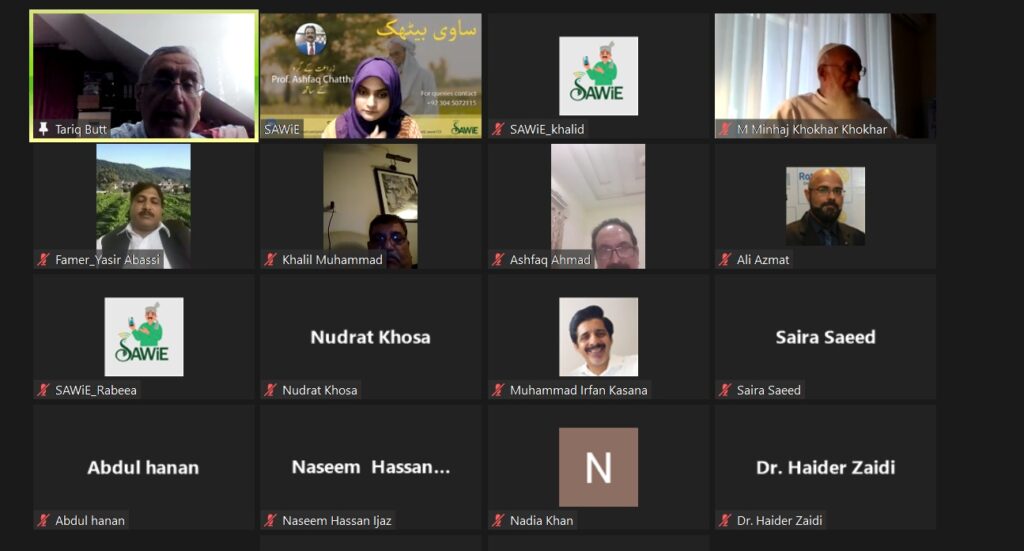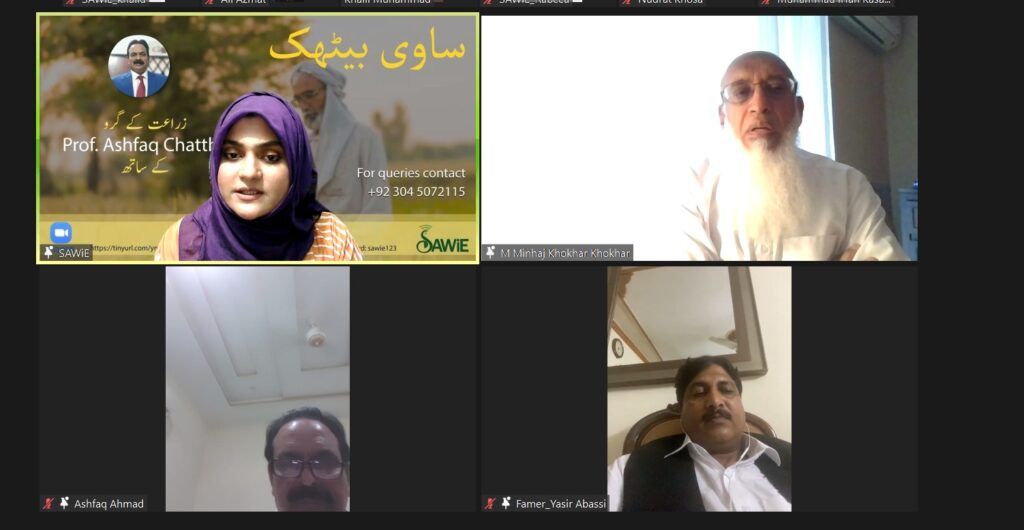SAWiE is an independent digital platform that provides remote Farm advisory based on scientific facts, proven good practices, and data-driven approaches using satellite technology. The platform enables smallholder farmers in developing countries to address the climate change crisis. They have chosen Pakistan as a pilot region to help smallholder farmers. Their smart solutions offer advice to farmers to better manage their crops and increase their income.
SAWiE aims to provide real-time, accurate, reliable, and effective information to farmers which is available at their fingertips through an App and a digital platform. SAWiE innovations support the farmers to address the climate change crisis to develop a resilient food system.
SAWiE is mindful and vigilant towards resolving the problems of farmers through a smart advisory system to monitor their crops and manage the irrigation, fertilizer, and crop protection when is required. To engage with the farmers, SAWiE has started a weekly farmer meeting -SAWIE Baithak to sit with an agriculture expert to receive answers to their questions.
The “SAWiE Baithak” aims at uplifting farmers’ knowledge through contributing knowledge and sharing good practices from the latest scientific innovations and utilizing the skills of agricultural experts.

Prof. Ashfaq Ahmad Chatha from the University of Faisalabad and a progressive farmer Mr. Yasir Abasi took part in the discussion with fellow farmers in session lead SAWiE Farm Advisory team represented by Miss Rikza Awan.
About fifty farmers and experts joined the Baithak to discuss Pakistan agriculture sector challenges and innovations to protect farmers’ income. The guests appreciated the theme of the “SAWiE Baithak” said, that bringing farmers, researchers and agricultural experts on this platform will help to improve understanding of the agriculture sector challenges to achieve the common goal of improving agriculture productivity of Pakistan Agriculture sectors.
The discussion started with asking questions from the online Audience
Prof. Chatha elaborated “Pakistan has progressed much better in the last 2 to 3 years than in the past. In 2020, more of the crops in Pakistan, specifical the five major crops i.e. wheat, rice, maize, cotton, and sugarcane produced a bumper crop than previous years”. Wheat production has reached 28 million tons as compared to the 26 million from the previous year. Pakistan is exporting more than US$ 2 billion. However, cotton production has deteriorated over the past few years.

Since the Green Revolution in 1962, wheat and other major crops’ production increased to a certain level but reached a plateau. But if we want to enhance it now, we need a systematic approach and take advantage of Industrial Revolution 4.0 which is equipped with digital innovation, big data, machine learning, and Artificial Intelligence.
Our farmers need to understand the importance of soil health, its nutrition, pH, water, change in weather patterns, different behaviors of seed genetics, new pests, and diseases. All this complexity is hard to understand with traditional approaches.
The use of remote sensing, GIS, new gadgets, IoT, and precision agriculture are proving very useful in the developed world. They managed to increase their crop yields. There is almost a 3-5-fold difference in crop yields of Pakistani farmers compared to Australian and American farmers.
This huge yield gap exists in most crops and widens further for our smallholders and progressive farmers due to a lack of knowledge and resources. This ends up lower productivity at the individual farm level and the overall country’s average yield. The simple approaches e.g. use of the certified and high-quality seed, land preparation, use of drill sowing, balanced use of fertilizer could help to double the existing yield.
Furthermore, there is a dire need to understand the water crisis, we should only irrigate crops when is necessary, apply pesticides when is best time to apply. We can reduce our harvest losses. Since the weather started shifting in recent years, we experience uncertain weather conditions during the time of harvest. It is quite wet and windy during the wheat harvesting season. This resulted in losing 20-30% crops every year due to this weather pattern.
Famers need to think and select wheat varieties that are early maturing. Farmers who are well aware of this challenge have already adopted such practices, they are achieving double the national average yield of wheat and other major crops in Pakistan.

The small landholders do not have access to the required production technology. They lack the investments and understanding to make such risky decisions. They have poor access to credit and machinery. The initiatives like SAWiE could make a step change to address this challenge by making farmers aware of the challenge and supporting connections to the supply chains in the future. This will help to improve their productivity by making the optimum use of inputs irrigation, fertilizer, and pesticides.
Pakistan’s cost of production is high due to a lack of efficiency in the system and will not be able to compete globally unless we cut down costs for our major crops of wheat, maize, sugarcane, and cotton. We could only increase the income of our local farmers through improving yield per acre and reduce costs of production. Of course, markets also play an important role. For that purpose, farmers need to work on crop diversification. There is a growing demand for fruits and vegetables to meet both domestic and international markets
Although our smallholders are very wise to test new technologies and are willing to buy it if it is profitable and sustainable. For instance, in Southern Punjab, cotton is cultivated on raised beds many years back, it was cultivated with seed broadcast or drill.
Pakistan is importing oil seed worth $4 billion that we could have grown in Pakistan especially in our rainfed Potohar and Thal region by providing incentives to the farmers. Pakistan has begun efforts to utilize such areas. PAMCO’s aim is to utilize the Thal area for orchards specifically for oilseed and citrus.
Prof. Chatha’s response to climate change effects in Pakistan was “From 2000 onwards we, as a team, started to develop infrastructure in the Agriculture University of Faisalabad for climate change. A lot of institutes were developed in other universities like the Agriculture University Peshawar for training experts on climate change and conducting research on it. To develop infrastructure and manpower, it was aimed to create a force tackling climate change with the latest technologies.”
“We stand at the 127th position in contributing to climate change. But we hold the 5th position in the list of countries being affected by it the most. The main problem of Pakistan is that because of a rise in temperature due to climate change, there is a need for more water and our existing system has a built-in fault causing more than 50% irrigation losses.
Pakistan’s agricultural sector should change the conventional farming system. For example, cropping patterns should be changed as there are several alternate crops that require less water and have a high yielding potential. This will help using less water, low crop production cost and gain better profitability eg Dwarf millet and Dwarf sorghum varieties suits semi-arid areas of Bhakkar and Layyah district, etc. These crops will be beneficial for smallholders, they can feed this to livestock. The grain can then be fed to our poultry industry reducing the import bill of Soyabean. Although I think Pakistan can grow its own Soyabean. They started doing trials which is a good new
If Pakistan needs to maintain stability in agriculture to feed a growing population, we should move towards crop diversification. We need extremely precise advisory services for the farmer to implement all these solutions.
Progressive Farmer Mr. Yasir Abassi shared his thoughts as they started growing Grapes and Olives in suburban areas of Islamabad. They are now getting 3-4 times higher income than traditional crops of wheat.
SAWiE intends to translate complex scientific principles into simple farming tips and good practices in order to improve the productivity and income of smallholders through its ecosystem approach.

